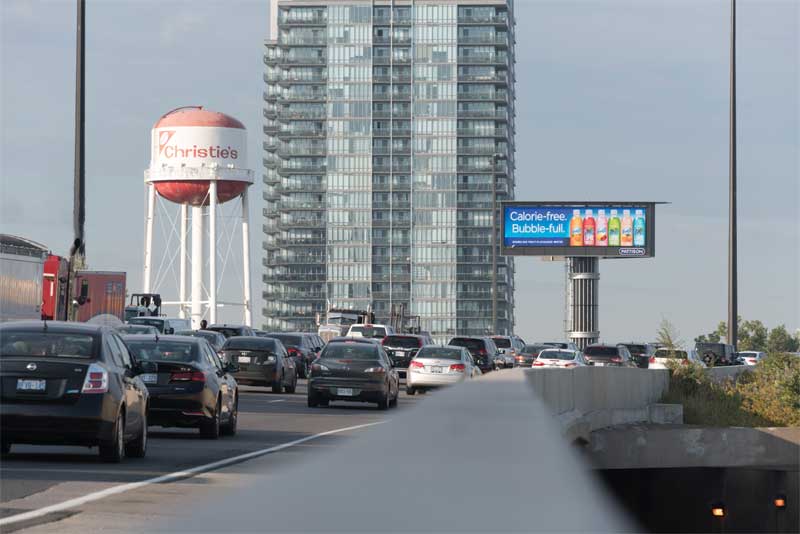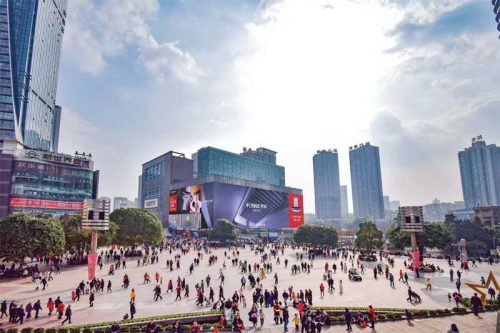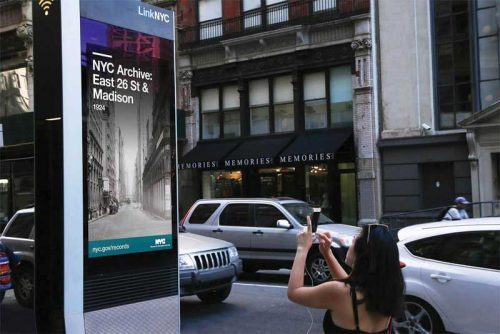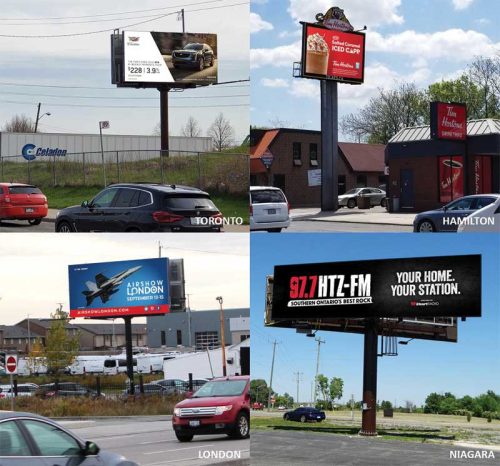What’s next for out-of-home?
by | 5 December 2019 3:11 pm
By Liseanne Gillham
 [1]
[1]When discussing the benefits of out-of-home (OOH) media, there is often mention of the fact that there is no fear of an ad being lost below the fold or those that are blocked/skipped.
These days, headlines about the state of the out-of-home (OOH) industry are invariably promising, with the medium seeing a resurgence of attention from business leaders around the world. In 2018, the industry was worth $31 billion, and it experienced a growth of about 4.5 per cent in 2019.
Further, the owners of the world’s biggest digital advertising platforms, such as Google, Facebook, and Amazon, buy a large amount of OOH advertising to promote their products and initiatives due to the platform’s ability to make messages big, bold, and bright. In fact, Facebook recently released a report, which promotes the benefits of combining Facebook ads with OOH.
So the question is, where is OOH headed? The growth the industry has experienced (and expects to see in the years ahead) is fuelled by a few key driving factors, largely rooted in new and creative technologies, which (simply put) works out to better content, more revenue, and a swift removal of many of the biggest barriers in the way of simple, streamlined OOH transactions for all.
OOH will get more dynamic, more interactive, and more eye-catching
 [2]
[2]In a survey by Content Marketing Institute (CMI), 81 per cent of respondents stated they believed interactive content was more effective at grabbing people’s attention than traditional media.
Almost all of the growth in the OOH space can be attributed to the industry’s digital development. Digital out-of-home (DOOH)
is the second-fastest growing medium in the world, right behind digital advertising.
A number of reasons are responsible for this growth. To begin with, static out-of-home requires a lot of advance planning and manual labour to prepare and post media, whereas digital assets can be updated automatically.
That said, there is an important creative advantage to digital out-of-home as well. DOOH supports moving images and content that generates dynamically in response to the presence of a particular audience or specific ambient conditions. With the right setup, it can even support viewers interacting with and manipulating onscreen imagery. Such creative output offers a high level of flexibility to build campaigns that draw large audiences and create a sense of excitement.
Further, research proves these styles of DOOH media are substantial improvements to those that have existed in the past. According to Neuroscience Research, full-motion DOOH is two-and-a-half times more effective than static OOH in driving an emotional response. Also, in a survey by Content Marketing Institute (CMI), 81 per cent of respondents stated they believed interactive content was more effective at grabbing people’s attention than traditional media.
Today, there is an increasing demand for DOOH media to make use of full-motion, dynamic content generation, or interactivity to properly harness the value of the media purchase. This trend is only expected to continue in the future and usher in new creative campaigns that delight audiences and push the medium to greater heights.
The promise of programmatic DOOH will be realized
 [3]
[3]Interactive screens like the LinkNYC totems showcase how out-of-home (OOH) can integrate with its environment.
Programmatic DOOH has finally arrived. For years, the industry had been anticipating the arrival of programmatic media with mixed feelings. Would enabling programmatic ad sales lead to a loss of control over what appears on a given screen, or lead to inventory devaluation? Would it lead to a new era of hyper-targeted, premium transactions that present better value to a buyer and seller alike? Undoubtedly, the response has been the latter.
Programmatic DOOH transactions are increasing every month and are making efficient, targeted purchases much easier than before. For example, when a mixed martial arts promotion company needed to make a last-minute venue change for its end-of-year event, it was able to simply shift its DOOH advertising’s targeting from place A to B and sell out its new venue in under a week. Likewise, other campaigns—from outdoor advertising to ads delivered inside of commercial buildings—have been successful in harnessing data and on-demand transactions to reach precise audiences at specific times.
This, arguably, is the most important trend to watch over the coming year. More networks are adding their inventory to the programmatic pool, and a growing number of buyers are seeking new markets and opportunities, all of which looks promising.
OOH will get better tied-in with its surroundings
 [4]
[4]Unlike ads on mobile devices or computers, out-of-home (OOH) exists as part of a physical environment. A billboard is not just a board, but a fixture of a particular geography.
When discussing the benefits of OOH, there is often mention of the fact that there is no fear of an ad being lost below the fold or those that are blocked/skipped. With ad-blockers alone costing U.S. publishers an estimated $15.8 billion in 2017, these are some substantial benefits indeed. There is another crucial advantage. Unlike ads on mobile devices or computers, OOH exists as part of a physical environment. A billboard is not just a board, but a fixture of a particular geography. The same can be said of posters, digital kiosks, and other types of media in the OOH family. Looking ahead, additional technology and planning will certainly help network owners use this strategy to their advantage.
Some of the highest-profile examples of this trend can be found in the rapidly growing smart city segment. Projects like the LinkNYC totems, which deliver free phone calls, Wi-Fi, maps, and other services to passersby are able to do so, thanks to advertising delivered on their OOH displays. The transit sector is another good example, with wayfinding terminals in train stations or on bus shelters serving both as a provider of essential services as well as an advertising medium. Both of these examples thrive because of their utility in the specific locations where the screens exist.
Even static OOH can get in on the act, as exemplified by McDonald’s ‘Follow the Arches’ advertising campaign, which turned careful crops of the brand’s logo into driving directions to a nearby restaurant. That said, the ads were not interchangeable—only specific crops that matched the local outlay of the road would work in this case.
Of course, DOOH has several other applications than just helping customers get from point A to B. In retail settings, interactive screens are used to help shoppers find items, check availability, access loyalty benefits, and even generate special discount codes while shopping. Stores can also tie in point-of-sale (POS) and inventory data to onscreen media that could be used to dynamically change which items are promoted in response to selling trends. Here again, the delivered content is relevant and valuable primarily because of where the screens are located.
For example, a screen that generates discount codes for a clothing brand would not be of much use in a local grocery store.
Looking at OOH in this manner and finding ways to maximize its context through its display locations is one of the best ways to unlock its true value, and is likely to take on increased importance across the industry.
OOH to amplify campaigns
 [5]
[5]Programmatic digital-out-of-home (DOOH) uses data triggers to deliver more relevant campaigns outside the home.
Today, there are multiple omnichannel campaigns, which involve many different channels and unique copy, imagery, or interactive capability tailored to the specific strengths of each advertising medium. OOH is being increasingly used in such campaigns due to greater access to programmatic OOH, as well as out-of-the-box application program interfaces (APIs) and data feeds that enable creatives to build complex campaigns more easily.
According to research by Nielsen, an American information, data, and measurement firm, OOH is particularly effective as an amplifier of ad campaigns delivered to mobile devices (perhaps, because these devices, too, venture out of the home). A media brand, for instance, combined DOOH and mobile ads to reach music festival-goers across the country. These advertisements were geo-targeted toward individuals who entered the range of these concerts. Meanwhile, digital advertising was strategically displayed at train stations across the country, appearing only on days when a festival was happening and only in the afternoons and evenings when festival-goers would be heading toward or leaving from the event. Over the course of the summer, the brand was able to reach more than 500,000 target members through this campaign, drawing nearly half of its audience from the DOOH side.
An increasing number of brands are moving toward OOH advertising to harness the full potential of this medium and connect with their audiences, but this alone is not the only force that is driving a growing interest among users. The availability of OOH inventory inside of the digital signal processors (DSPs) that media buyers already use for their other programmatic transactions is likely to continue to propel omnichannel advertising with OOH to even greater heights. The easier it is for digital marketing
pros to buy OOH, the more they will buy it.
With some of the largest changes in the OOH space driven by new technology, like programmatic transactions and dynamic and interactive capabilities, the space is growing to be the playground for visionaries who are willing to experiment on the technical side of their OOH networks. A rapid influx of new blood into the industry, too, is sure to drive many creative campaigns and growth in the coming years.
Liseanne Gillham is vice-president of marketing at Broadsign, a Montreal-based provider of out-of-home (OOH) marketing technology. She oversees the company’s global marketing functions, helping to educate both media owners and digital buyers on the benefits of static, digital, and programmatic OOH. Gillham has held senior marketing leadership roles for high-growth technology companies in the retail, advertising, and creative industries; consulted many tech startups; and overseen communications for several high-profile venture capital funding rounds. She can be reached at liseanne.gillham@broadsign.com.
- [Image]: https://www.signmedia.ca/wp-content/uploads/2019/12/Photo-Courtesy-of-PATTISON-1.jpg
- [Image]: https://www.signmedia.ca/wp-content/uploads/2019/12/Header-image.jpg
- [Image]: https://www.signmedia.ca/wp-content/uploads/2019/12/Image-3.jpg
- [Image]: https://www.signmedia.ca/wp-content/uploads/2019/12/Photo-Courtesy-of-Media-City.jpg
- [Image]: https://www.signmedia.ca/wp-content/uploads/2019/12/Image-2-1.jpg
Source URL: https://www.signmedia.ca/whats-next-for-out-of-home/